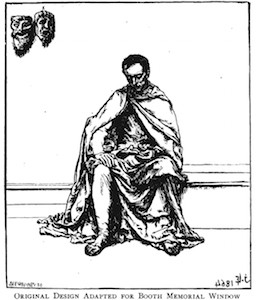Church of the Transfiguration
The Church of the Transfiguration, also known as “The Little Church Around the Corner,” is famous in theatrical circles. The church was built in 1849 by an unknown architect. It contains one of the most remarkable stained glass windows by John La Farge.
In 1895, John La Farge was commissioned to make a memorial window for Edwin Booth (1833-1893), the most famous Shakespearean actor of his era. He was also the older brother of John Wilkes Booth (1838-1865), the man who assassinated Abraham Lincoln. Between 1879-83, Edwin Booth developed a notable summer cottage in the Paradise Valley region of Newport, RI, where John La Farge had also lived.[1]
The design for the Booth window is based on an earlier illustration for Dramatis Personae, a collection of poems by Robert Browning.[2]

John La Farge: illustration for Dramatis Personae, by Robert Browning 1864.
The image of an actor contemplating a theatrical mask was appropriate for Booth. La Farge made no attempt to render the features of Booth. Lafarge explained the meaning of his design in a letter to Russell Sturgis which was printed in The Evening Post[3]:
I had wished, and the committee with me, that our memorial might be specially an actor's memorial, suitable, of course, to a church. The desire to represent Mr. Booth we put aside. I preferred a treatment or choice of subject which might bring up or bring in association the ideas of a life beyond the grave ; and I thought I had found this solution by the representation of an actor looking at his mask. The subject had the advantage of being a classical one, and of recalling the religious meaning connected with the mask—the person, as Jeremy Taylor calls it. You know, of course, that our word “person,” as shown by this reference, means a mask-the part we play on this stage—our character—the station in life to which it has pleased God to call us. A celebrated actor himself has repeated the commonplace statement that all the world's a stage.
I placed behind my actor, attired in Graeco-Roman costume, the curtain or the veil behind which we retire; and in the architectural framework behind him I tried again to recall the association of the stage with religion by a little altar. The stage, as you know, in all lands, was first connected with mysteries, and the name for the early mediaeval acting is again mystery.
In the base of the window, as at first designed, I had placed an ornamental grouping of the emblems which connect the Greek stage with the Greek religious mysteries—the veil, the emblematic foliage, the sacred table and vessels, and the mask which represented again the life in this world over which we have only a partial control. The committee, however decided that they would devote the entire lower part of the window to the quotation from “Hamlet” which runs:-
“As one, in suffering all, that suffers nothing,
A man that fortune 's buffets and rewards
Hast ta'en with equal thanks.”
(‘Hamlet,’ iii, 2.)
This quotation had been used by Mr. Booth in a letter to a friend, in which he spoke of a desire of having it placed upon his tomb.
The dedication at the bottom of the window reads: “To the glory of God and in loving memory of Edwin Booth. This window has been placed here by the players, 1898.”
Notes
[1] See James L. Yarnall, “Edwin Booth’s Life in Paradise,” Newport History, 68 (3, 1997): 112-136.
[2] The 1864 drawing is reproduced in George Parsons Lathrop, "John La Farge," Scribner's Monthly, 21 (February, 1881): 504.
[3] Quoted in ”The Edwin Booth Memorial Window,” in The Critic, 33 (July-Aug., 1898): 61-63.
